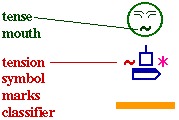Two Notation Systems for Signed Languages: Stokoe Notation & Sutton SignWriting Joe Martin Western Washington University Martinj4@cc.wwu.edu |
||||||||||||
|
5. NMGSs
SN ignores NMGS, and for an interesting reason. Stokoe realized that it was an "integral part of the formation of a sign" but analysis of them "presents many difficulties" and "will be much more feasible after the analysis of the basic aspects" had been carried out (Stokoe 1960, 38). He was wise to do this; today at least six channels by which information is transmitted in Signing have been identified beside the use of the hands: Facial Expression, Eye Gaze, Lip Movement, Body Posture, and Shoulder and Head Position (Kyle & Woll 29). All of these are shown in SSW. In fact chapters 10 and 11 of the SSW textbook are entitled "Facial Expressions" and "Head & Body" respectively, and show these in the usual schematic way (Sutton 1997a). English phrases like "she said happily," can be signed in ASL with a typical adverb, basically a smile, which in SSW looks like a little happy face. Children's stories in SSW are often full of these (Figure 11f) |
||||||||||||
|
|



